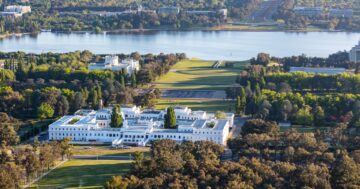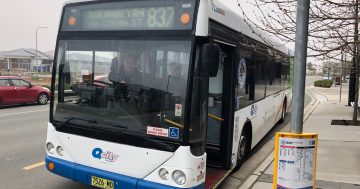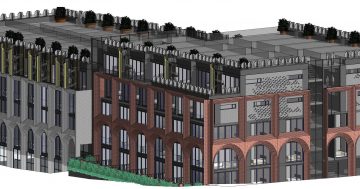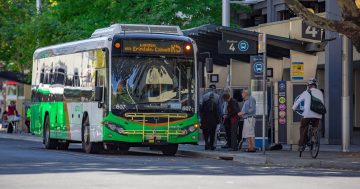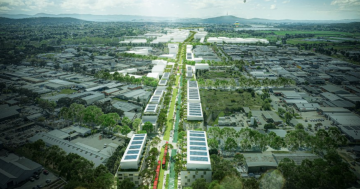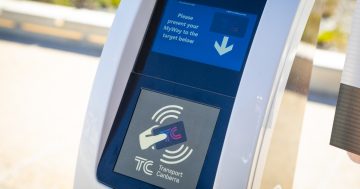
This time last month I wrote here about why I think Canberra needs to rethink its transport. On reflection, and thanks in no small part to some constructive commentary, I see the concept I tried to outline could have been better articulated. By stating, ‘Canberra needs to rethink its transport’, is not to say ‘Canberrans need to rethink their transport’. Indeed, it is completely unreasonable to ask people with kids living in our more outer suburbs to do all they need to do on a bus, or for tradies to bicycle their tools to the worksite each day. But, this isn’t the point I was trying to make. My point is, collectively, we need to support strategic planning decisions aimed at the result of a more liveable city.
Canberra’s urban form today is a result of planning decisions made by the National Capital Development Commission (NCDC) in the mid-to-late twentieth century. The NCDC was responsible for the ‘Y’ plan and the development of Canberra’s ‘satellite cities’ of Woden, Belconnen and Tuggeranong, all interconnected and interlaced by high capacity, high speed road networks. At the time this was a visionary attempt to create a city comfortably nestled in its bush setting, with jobs, services and amenities decentralised to the suburbs, and high accessibility provided by non-congested roads. I’m sorry to say, however, this type of city layout, one characterised by high car dependency, high infrastructure demands, and isolated land uses, is economically and socially unsustainable, particularly when considered in the context of the modern knowledge economy.
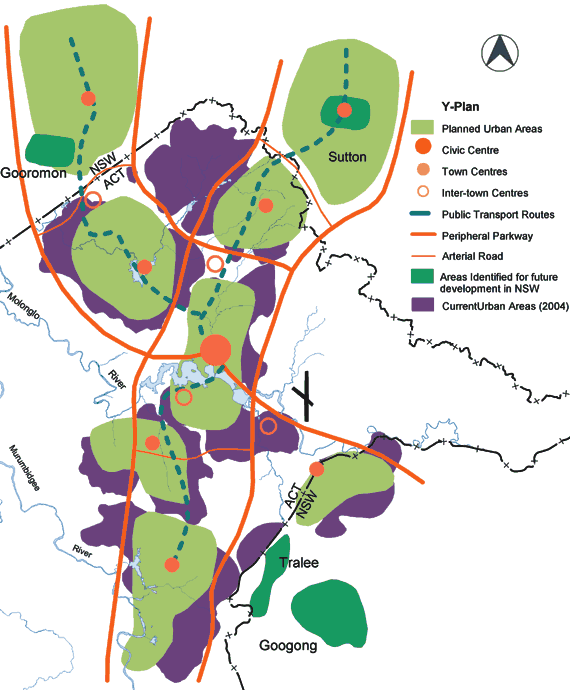
The ‘Y’ Plan, courtesy of ACTPLA.
More and more today as our nation transforms from an industrial base towards a more knowledge and services based economy, we see the effect of jobs markets becoming highly concentrated into our urban cores. For example, the CBDs of Sydney and Melbourne, a combined area of just over seven square kilometres, generate almost 10 per cent of all economic activity in Australia. Canberra hasn’t escaped this phenomenon, with the Federal government seeking to rationalise its property portfolio and move departments as close to Parliament House as possible, and many knowledge based businesses choosing the city as their desired location.
This concentration of employment contributes to rising housing prices as a higher number of people seek to live in proximity of places of employment, or good accessibility to those locations. And while places like Belconnen, Braddon, New Acton and Northbourne Avenue have seen the development of high rise apartment buildings which provide greater accessibility for smaller households of 1-3 people, my question is, where are the places for families? The bulk of Canberra’s working families, if they want a dwelling large enough, (or one that’s affordable), are effectively given one option – a standalone house in the burbs. It’s these single use, sprawling suburbs which are subject to the disappearing local schools, shops and services, while extended the paltriest of bus services as the only non-car option linking them to the job markets, schools, and amenities increasingly concentrated in distant places.
What occurs when an ever growing body of people, effectively forced into car ownership, have to travel to a finite space to access jobs, services, and/or amenities? Traffic. Lots of traffic. Traffic which brings with it increasing commute times, loss of productivity, and reduced amenity in what should otherwise be a walkable urban area. Being stuck behind the wheel impacts our health, takes away time with our loved ones, and costs us serious money, (it costs $15,000 per year on average to own and run a car, and lets not even mention the social costs of infrastructure, policing, accidents, insurance etc). And if you build a city for driving, as the NCDC did for 30 years, then naturally you’re going to end up with a city where everyone drives, along with a mounting road upgrade and maintenance bill. It’s a negative spiral, the effects of which will only get worse as our population increases and we continue to build car dependent, sprawling suburbia on our city’s outskirts.
If we want an affordable, accessible, and vibrant city then we need to stop building it the way we have been. Stand-alone housing spreading out like a carpet, complemented by bucket loads of high rise apartments in town centres, (often lacking decent street level environments), is not the answer. Where are the options in the middle? The type of low-rise, yet high-density developments where some personal space is traded off for a high quality public realm, which in turn establishes a critical mass for the viability of locally based small business and high frequency public transport, is almost totally lacking in Canberra. Looking at other cities around the world it’s easy to identify these types of neighbourhoods as they’re now almost always the most desirable, and ergo, most expensive places to live. Places like Surry Hills in Sydney, Carlton in Melbourne, Beacon Hill in Boston, Brooklyn in New York City, and just about every European town you can think of, provide a variety of housing choice while having sufficient density that a diversity of public and private investments in communal facilities can be realised. The greater presence of better designed local parks, town squares, walkable streets, playgrounds, and well supported local small businesses brought about by this type of development not only increases economic vitality, it also provides a higher level of social inclusiveness to residents.
Beacon Hill, Boston.
Beacon Hill, Boston.

Example of Swedish medium density development.

Example of Swedish medium density development.
Sadly, as I see it, the only place where we come close to this type of environment in Canberra is Kingston, and in particular, the Kingston Foreshore. And while I’ve heard many people lament how the Kingston Foreshore has damaged our lakeside environment, and how ugly it looks, I’m afraid Canberrans are voting with their feet, and their money. There are reasons property values in the area are so astronomically high, and it has a lot to do with how much access people living there have to amenities, public services, and job markets, and how little there is of it. The Kingston Foreshore provides residents superb access to amenities such as the lake, cafes, restaurants, parks, schools and cultural institutions. It is located immediately adjacent to a high frequency bus route and has high accessibility for multiple other transport options including walking, cycling, driving, and even the train. And it is readily linked via these multiple transport options to several employment centres such as the City, Fyshwick, Russell, Woden, Brindabella Park and the Parliamentary Triangle. Go to the Kingston Foreshore on any night of the week, or during the weekend, and you’ll find large numbers of people frequenting the area, pumping life and urbanity into our city in a way rarely seen.

The Kingston Foreshore, courtesy of Kingsborough.com.au.
Having said all this the question must then come back to why I make the statement ‘Canberra needs to rethink its transport’. The simple fact is that our land use and our transport are inextricably linked to one another. If we decree that our primary transport method is the car, and that all of our land use must be based on that assumption, then we will only ever end up with suburban sprawl and inhospitable, inefficient, parking lot splintered commercial areas, (just look at Woden, and Tuggeranong for example). We don’t end up with types of places like the Kingston Foreshore which derive a great deal of their value from being walkable, and cycling and transit friendly. If one thing is certain about the modern knowledge economy it’s that employment concentration means people will have to live closer to one another if they’re to maintain reasonable accessibility to their workplace. We need more places like the Kingston Foreshore to be built around Canberra, giving more people greater housing choice, more transport options, and better accessibility to social and public amenities.
What do you think? Do we need to reprioritise our transport planning?














